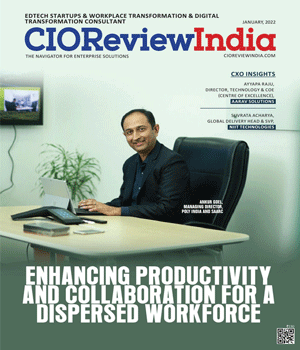
Vulnerability In Digital Banking In The New Normal
Suvrata Acharya, Global Delivery Head & SVP, NIIT Technologies
 In last ten years we saw a transformational change in the overall consumer experience in the banking industry. While most of the banks were competing against each other in offering an omni channel experience to their customers, policy makers were helping the journey by bringing a monumental change in banking infrastructure. New payment interfaces and ‘Platformification' of banking services have brought the transformation in retail banking. Financial transactions powered by new generation technologies have become faster and ubiquitous. But the real test came when the pandemic hit and lockdown forced people to stay at home. This exposed the vulnerability in the banking services in this new normal environment.
In last ten years we saw a transformational change in the overall consumer experience in the banking industry. While most of the banks were competing against each other in offering an omni channel experience to their customers, policy makers were helping the journey by bringing a monumental change in banking infrastructure. New payment interfaces and ‘Platformification' of banking services have brought the transformation in retail banking. Financial transactions powered by new generation technologies have become faster and ubiquitous. But the real test came when the pandemic hit and lockdown forced people to stay at home. This exposed the vulnerability in the banking services in this new normal environment.
Lockdown completely crippled down the customer services provided by the institutions. While the basic services were made available online, banks grappled with the shortage of workforces that could provide full services. Consumers faced enormous difficulties in getting services that were not available online. Moreover, the online transactions were not convenient for most of the consumers due to the intricacy involved in using it.
On the other side, pandemic made it imperative for the merchants to adopt Touchless payment mechanism to service their customers. Mobile wallet companies reap the benefits by expanding their market presence. While it works well for the small merchant, but the gap was noticed in the case of midsize merchant that was looking for more credit based options. In India, cardbased payment processing is primarily handled by the banks, which control both consumers and merchants. Banks could not scale up to meet the new demand due to limited availability of the technologies and operation.
"Mobile wallet companies reap the benefits by expanding their market presence"
As the business shifted to online, it helped the e-Commerce players who already have the latest technologies and integrated payment systems. Global players have a bigger advantage over local players as they have already invested in advanced cloud based technologies with fully automated processes. Cloud and automation bring the nimbleness to address the new demands. It helped to bring the changes to the existing supply chain at a faster pace. Few food delivery service aggregators launched the new functionality in just few days. At the same time, the market penetration of e-Commerce is still very low. In India it is still less than 5% of overall retail market, whereas in countries like China it is more than 35%. The bank could play a key role as it has higher market penetration and it plays a credit facilitator for many small and medium sized merchants. It can play key roles in bringing localization and improving accessibility of e-Commerce in under penetrated markets.
Most of the banks are still dealing with a legacy core system that is highly manpower dependent. Without putting additional manpower, they are struggling to scale up the operation. The pandemic restricted the availability of manpower. The solution lies with the open banking models that enables the componentized the services through APIs. This will help the banks to decouple their products and services. By prioritizing the implementation of open banking, banks can engage third party fintech players to drive the innovation in banking services. The new technology providers can innovate with the data provided by the banks and build solutions around new consumer or merchant onboarding and other value added ancillary services. There are several point solutions offered by FinTech globally, which can be replicated in India faster. Post pandemic environment will demand more financial inclusion and solutions in the area of micro lending and peer to peer lending. This is also critical to bring the pandemic affected people, especially migrants to generate new avenues of earning. Globally, there are several platforms offering various loan products such as student loans, purchase specific financing, personal loan, etc. They offer secured/unsecured financing based on the credibility determined through alternative data sources (such as employment, habits, education etc.). The pandemic has already created a social environment with higher levels of public co-operation. This environment is conducive to promote mobile apps which can make financial transaction at peer to peer basis.
CIO Viewpoint
Why Foolproof Facial Recognition Is Key Against...
By Joseph Sudheer Thumma, Global CEO & MD, Magellanic Cloud
National Technology Day 2025: Powering Progress...
By CIOTech Outlook Team
Aligning IT Roadmap with Business Objectives: A...
By Subhash singh Punjabi, CISO & Head Enterprise Architecture, Deepak Fertilisers & Petrochemicals Corporation Ltd
CXO Insights
Revolutionizing Small-Scale Electronics:...
By Dr. Prince Joseph, Group CIO, SFO Technologies
Accelerating India's Digital Renaissance...
By Tak lee, CEO and Managing Partner, Hashedem
How leveraging technology solutions automates...












